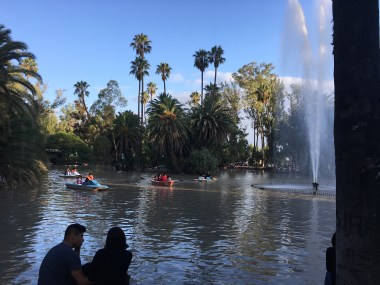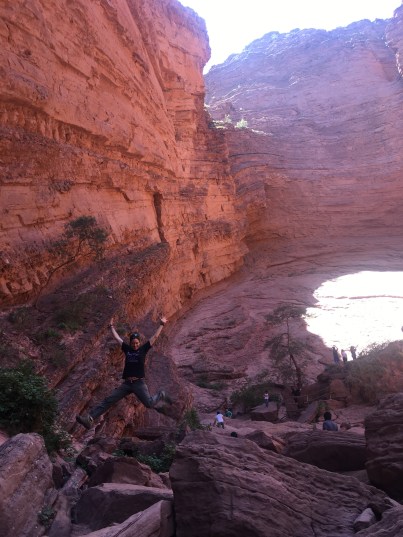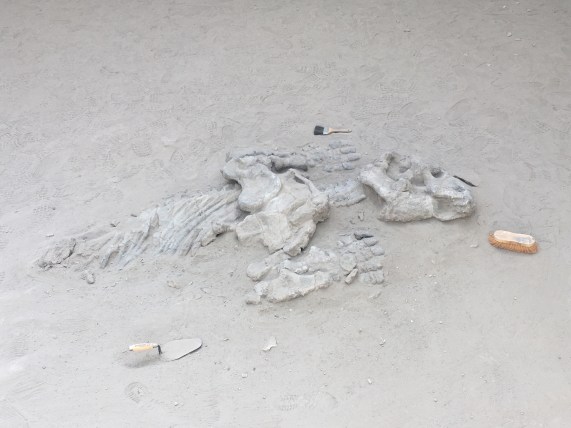The “Camino de los Siete Lagos” (or 7 Lakes Route) supposedly ends (or begins) in Villa de la Angostura, but continuing south you will find the popular ski and hiking city of Bariloche on the southern side of the beautiful lake Lake Nahuel Huapi. Located within the National Park with the same name (Parque Nacional Nahuel Huapi), Bariloche is situated on the lake and surrounded by beautiful forests, mountain-like hills, streams, and other lakes – a paradise for hikers, rock climbers, kayakers, wind surfers, and anyone who loves to visit the outdoors and see breath-taking landscapes.

Besides being blown away by its amazing lakeshore view, my first impression of Bariloche was that it reminded me of Boulder, Colorado. I guess I wasn’t too far off because I was told it’s sister cities with Aspen. On one hand, the local feel was that it was full of outdoor enthusiasts and also had a pretty big hippy-like culture. At the same time, it was very much a tourist town,* with streets lined with businesses of all kinds, but a very notable amount of outdoor clothing and equipment shops, tourist information, health food stores, and chocolate shops. That’s right, Bariloche is also known across Argentina not only for its skiing but for its chocolate!

The city extends along the southern side of the lake Nahuel Huapi for about 20 km towards the peninsula and the city park Llao Llao, with unlimited beautiful sites to see along the way. Some of the most popular include visiting beaches along one of the lakes, climbing to the top one of the many hills that offer incredible views of the area, hiking through different trails in the park or around the lakes, visiting an old Swiss colony, or just exploring the city center.

I happened to arrive for International Women’s Day, so there was a march through the city, ending in the plaza (which looks out over the lake). I caught the end of it in the plaza when there were still around 100 people – men, women, and children – gathered, holding banners and signs, wearing green handkerchiefs,** and cheering as speakers spoke about the progress that had been made in human rights and the set-backs and modern-day challenges that Argentina faced currently. While the focus was on women’s rights and issues – domestic violence, freedom to legal and safe abortions, equal opportunities and pay – I was impressed that they chose to be inclusive and talk about basic human rights in general, bringing attention to injustices harming indigenous communities, impoverished communities, and LGBT+ persons.

The days were beautiful, with full sunshine that felt like summer during mid-day and cooled off quickly when the sun started to go down. There was always an energy buzzing as the streets, parks, beaches, and buses (“colectivos”) were full of people out to enjoy the outdoors – many that lived in the area but also a ton of people on vacation from Buenos Aires. The great thing about Bariloche is there are a ton of day hikes you can do and places you can visit and enjoy in just one day or a half day. But there are also a few overnight hiking and camping adventures, like Refugio Frey or climbing El Cerro Tronodor, which is on the border with Chile.
I barely got a chance to scratch the surface of all the popular places to visit, but each day I hopped on the city bus to go explore a new place.
First, I headed off to Cerro Campanario, where, (similar to Monserratte in Bogotá and Cerro San Bernardo in Salta), there was a teleferico (ski-lift-like cable car) that you could take up to the top of the hill overlooking the city.

Or, you could take the walking path and hike up to the top. (It was in this hike, where I ran into my friends the San Juaninos, Liliana and Edgardo!)

From the top, there was almost a 360-degree view of Lake Nahuel Huapi on one side, and the hills, forest and other lakes on the other side.

There was a beautiful overlook point with chairs, where people were sitting and staring out over the lake, just drinking in the beautiful view. A family came, and the mom had prepared a cake and pretended to sell it to her three kids, “charging” them each a few pesos.
Another day, I took a 40-minute bus ride out to the Municipal Park Llao Llao, about a 20-minute walk from the last bus stop where they leave you at Hotel Llao Llao.

There are a ton of trails in this park and you could spend all day exploring all the different nooks and crannies or just take a leisurely hike along one of the trails.

I spent most of the day walking around Lago Moreno, and incredibly serene and gorgeous lake that I just couldn’t stop taking photos of.

Interestingly enough, I would be spending about a month in quarantine at the opposite end of this lake (not visible from where I was because it is quite large).
Famous Footnotes:
*A huge part of the economy is based around tourism, including the winter ski season. Many friends I met were guides.
**The green bandana is a symbol representing women’s rights and specifically a call for safe and legal abortion as an option for women. As I mentioned in a previous post, it is currently a hot topic and many people brought it up in conversations we had.










 Oscar also introduced me to the card game “escoba” (“broom”), which uses a Spanish deck of cards similar to the traditional poker deck… but completely different. It does not include the 8, 9 and 10 cards, so the jack is worth 8 (though it is marked with a “10”), there’s a horse worth 9 (though it is marked with an “11”), and the king is worth 10 (though it is marked with a “12”). To score points, you then have to make hands that add up to 15, remembering that some cards aren’t actually worth their face value. In conclusion, it is really confusing and challenging (but fun).
Oscar also introduced me to the card game “escoba” (“broom”), which uses a Spanish deck of cards similar to the traditional poker deck… but completely different. It does not include the 8, 9 and 10 cards, so the jack is worth 8 (though it is marked with a “10”), there’s a horse worth 9 (though it is marked with an “11”), and the king is worth 10 (though it is marked with a “12”). To score points, you then have to make hands that add up to 15, remembering that some cards aren’t actually worth their face value. In conclusion, it is really confusing and challenging (but fun).









































































